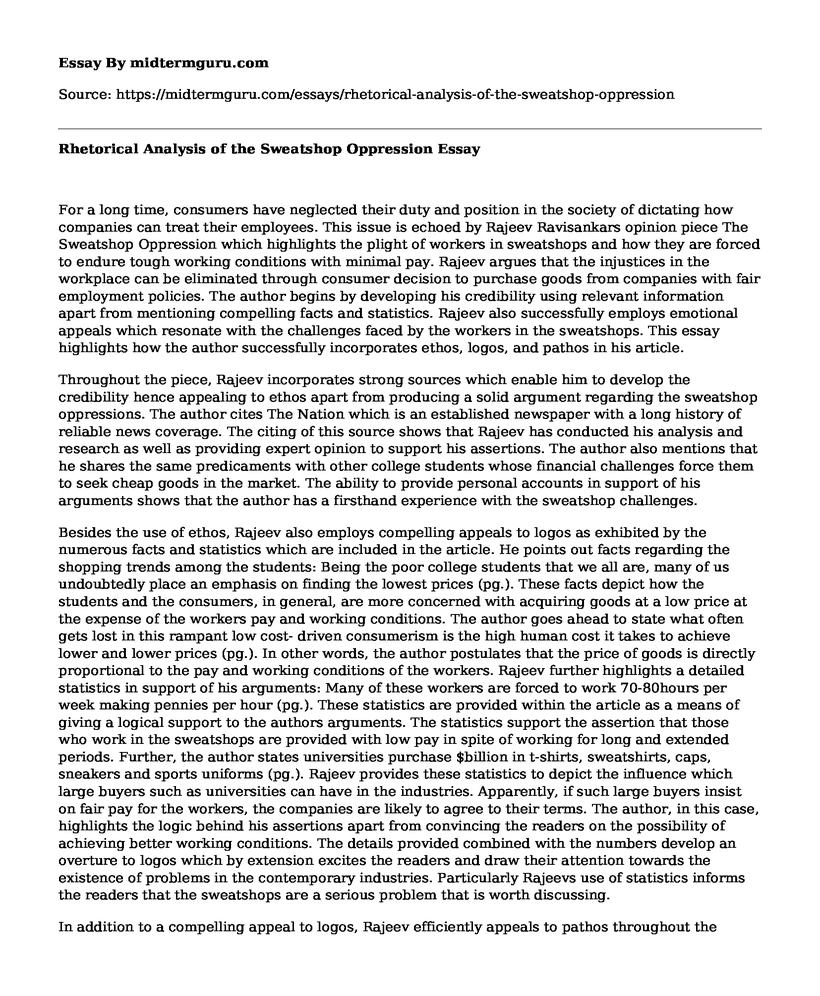For a long time, consumers have neglected their duty and position in the society of dictating how companies can treat their employees. This issue is echoed by Rajeev Ravisankars opinion piece The Sweatshop Oppression which highlights the plight of workers in sweatshops and how they are forced to endure tough working conditions with minimal pay. Rajeev argues that the injustices in the workplace can be eliminated through consumer decision to purchase goods from companies with fair employment policies. The author begins by developing his credibility using relevant information apart from mentioning compelling facts and statistics. Rajeev also successfully employs emotional appeals which resonate with the challenges faced by the workers in the sweatshops. This essay highlights how the author successfully incorporates ethos, logos, and pathos in his article.
Throughout the piece, Rajeev incorporates strong sources which enable him to develop the credibility hence appealing to ethos apart from producing a solid argument regarding the sweatshop oppressions. The author cites The Nation which is an established newspaper with a long history of reliable news coverage. The citing of this source shows that Rajeev has conducted his analysis and research as well as providing expert opinion to support his assertions. The author also mentions that he shares the same predicaments with other college students whose financial challenges force them to seek cheap goods in the market. The ability to provide personal accounts in support of his arguments shows that the author has a firsthand experience with the sweatshop challenges.
Besides the use of ethos, Rajeev also employs compelling appeals to logos as exhibited by the numerous facts and statistics which are included in the article. He points out facts regarding the shopping trends among the students: Being the poor college students that we all are, many of us undoubtedly place an emphasis on finding the lowest prices (pg.). These facts depict how the students and the consumers, in general, are more concerned with acquiring goods at a low price at the expense of the workers pay and working conditions. The author goes ahead to state what often gets lost in this rampant low cost- driven consumerism is the high human cost it takes to achieve lower and lower prices (pg.). In other words, the author postulates that the price of goods is directly proportional to the pay and working conditions of the workers. Rajeev further highlights a detailed statistics in support of his arguments: Many of these workers are forced to work 70-80hours per week making pennies per hour (pg.). These statistics are provided within the article as a means of giving a logical support to the authors arguments. The statistics support the assertion that those who work in the sweatshops are provided with low pay in spite of working for long and extended periods. Further, the author states universities purchase $billion in t-shirts, sweatshirts, caps, sneakers and sports uniforms (pg.). Rajeev provides these statistics to depict the influence which large buyers such as universities can have in the industries. Apparently, if such large buyers insist on fair pay for the workers, the companies are likely to agree to their terms. The author, in this case, highlights the logic behind his assertions apart from convincing the readers on the possibility of achieving better working conditions. The details provided combined with the numbers develop an overture to logos which by extension excites the readers and draw their attention towards the existence of problems in the contemporary industries. Particularly Rajeevs use of statistics informs the readers that the sweatshops are a serious problem that is worth discussing.
In addition to a compelling appeal to logos, Rajeev efficiently appeals to pathos throughout the article. The introduction section, for instance, is characterized by emotionally charged words which evoke sympathy feelings. For instance, he indicates how the financial challenges force most university students to opt for cheaper goods at the market. In the fourth paragraph, Rajeev states They must fulfill certain quotas for the day and stay extra hours (with no pay) if these are not fulfilled. Some are forced to sit in front of a machine for hours as they are not permitted to take breaks unless the manager permits them to do so (pg.). The facts highlighted depict the deplorable conditions which the workers in the sweatshops are forced to persevere. The writer included this description to attract the readers sympathy and attention to the challenges faced by the workers. Rajeev also provides a description of the bathrooms and how the workplaces lack ventilation. Such descriptions evoke negative reactions regarding the sweatshops which makes the reader take seriously the issues being discussed.
Rajeev has effectively utilized rhetorical tools to convey his assertions regarding the challenges faced by the workers in sweatshops. Consequently, the readers who may not have been familiar with the issues before are informed and made to rethink their perceptions of the same. The author achieves this objective through the use of pathos, ethos, and logos which evoke the readers emotions and subsequently attracting their concentration.
Work cited
Ravisankar, Rajeev. Sweatshop Oppression. The Lantern. April, 9th 2006.
Cite this page
Rhetorical Analysis of the Sweatshop Oppression. (2021, Oct 01). Retrieved from https://midtermguru.com/essays/rhetorical-analysis-of-the-sweatshop-oppression
If you are the original author of this essay and no longer wish to have it published on the midtermguru.com website, please click below to request its removal:
- Literature Review of The New Role of the World Bank by Michael A Clemens and Michael Kremer
- Essay on Difference Between Restaurant and Hotel
- Essay on the Article The Iron Cage Revisited by Dimaggio and Powell
- Essay on Hotel Monaco Chicago: Value Creation
- Analysis of New Mission of the Thomas Cook Airlines Company - Paper Example
- Automating Excel & Access with Macros & VBA
- Mixed Methodology: Combining Quantitative & Qualitative Research - Essay Sample







